新目标七年级下册英语Unit 8如何用英语问路指路
新人教七年级下册英语unit-8重点知识点解析及练习(无答案
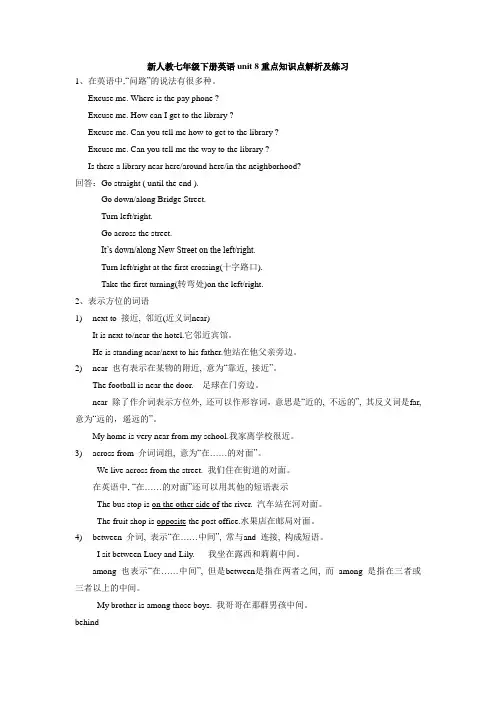
新人教七年级下册英语unit 8重点知识点解析及练习1、在英语中,“问路”的说法有很多种。
Excuse me. Where is the pay phone ?Excuse me. How can I get to the library ?Excuse me. Can you tell me how to get to the library ?Excuse me. Can you tell me the way to the library ?Is there a library near here/around here/in the neighborhood?回答:Go straight ( until the end ).Go down/along Bridge Street.Turn left/right.Go across the street.It’s down/along New Street on the left/right.Turn left/right at the first crossing(十字路口).Take the first turning(转弯处)on the left/right.2、表示方位的词语1)next to 接近, 邻近(近义词near)It is next to/near the hotel.它邻近宾馆。
He is standing near/next to his father.他站在他父亲旁边。
2)near 也有表示在某物的附近, 意为“靠近, 接近”。
The football is near the door. 足球在门旁边。
near 除了作介词表示方位外, 还可以作形容词,意思是“近的, 不远的”, 其反义词是far, 意为“远的,遥远的”。
My home is very near from my school.我家离学校很近。
3)across from 介词词组, 意为“在……的对面”。
人教版英语七年级下册Unit8 单元目标解读
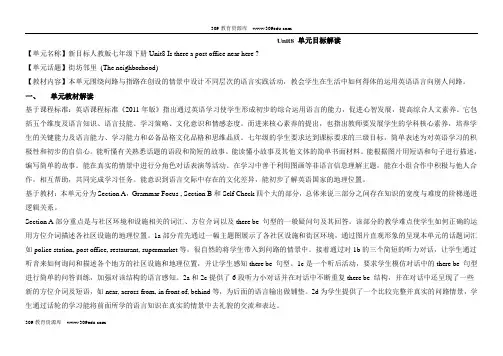
Unit8 单元目标解读【单元名称】新目标人教版七年级下册Unit8 Is there a post office near here ?【单元话题】街坊邻里(The neighborhood)【教材内容】本单元围绕问路与指路在创设的情景中设计不同层次的语言实践活动,教会学生在生活中如何得体的运用英语语言向别人问路。
一、单元教材解读基于课程标准:英语课程标准《2011年版》指出通过英语学习使学生形成初步的综合运用语言的能力,促进心智发展,提高综合人文素养。
它包括五个维度及语言知识、语言技能、学习策略、文化意识和情感态度。
而进来核心素养的提出,也指出教师要发展学生的学科核心素养,培养学生的关键能力及语言能力、学习能力和必备品格文化品格和思维品质。
七年级的学生要求达到课标要求的三级目标,简单表述为对英语学习的积极性和初步的自信心。
能听懂有关熟悉话题的语段和简短的故事。
能读懂小故事及其他文体的简单书面材料。
能根据图片用短语和句子进行描述,编写简单的故事。
能在真实的情景中进行分角色对话表演等活动。
在学习中善于利用图画等非语言信息理解主题,能在小组合作中积极与他人合作,相互帮助,共同完成学习任务。
能意识到语言交际中存在的文化差异,能初步了解英语国家的地理位置。
基于教材:本单元分为Section A,Grammar Focus , Section B和Self Check四个大的部分,总体来说三部分之间存在知识的宽度与难度的阶梯递进逻辑关系。
Section A部分重点是与社区环境和设施相关的词汇、方位介词以及there be 句型的一般疑问句及其回答。
该部分的教学难点使学生如何正确的运用方位介词描述各社区设施的地理位置。
1a部分首先通过一幅主题图展示了各社区设施和街区环境,通过图片直观形象的呈现本单元的话题词汇如police station, post office, restaurant, supermarket等,很自然的将学生带入到问路的情景中。
新人教版七年级英语下册unit8问路和指路英语大全
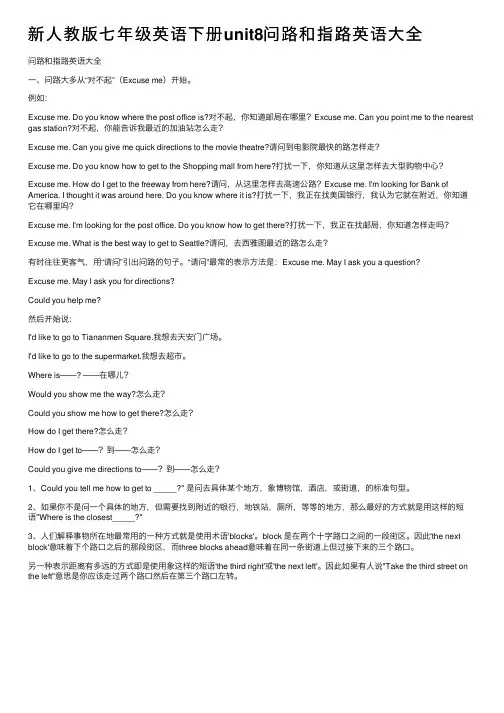
新⼈教版七年级英语下册unit8问路和指路英语⼤全问路和指路英语⼤全⼀、问路⼤多从“对不起”(Excuse me)开始。
例如:Excuse me. Do you know where the post office is?对不起,你知道邮局在哪⾥?Excuse me. Can you point me to the nearest gas station?对不起,你能告诉我最近的加油站怎么⾛?Excuse me. Can you give me quick directions to the movie theatre?请问到电影院最快的路怎样⾛?Excuse me. Do you know how to get to the Shopping mall from here?打扰⼀下,你知道从这⾥怎样去⼤型购物中⼼?Excuse me. How do I get to the freeway from here?请问,从这⾥怎样去⾼速公路?Excuse me. I'm looking for Bank of America. I thought it was around here. Do you know where it is?打扰⼀下,我正在找美国银⾏,我认为它就在附近,你知道它在哪⾥吗?Excuse me. I'm looking for the post office. Do you know how to get there?打扰⼀下,我正在找邮局,你知道怎样⾛吗?Excuse me. What is the best way to get to Seattle?请问,去西雅图最近的路怎么⾛?有时往往更客⽓,⽤“请问”引出问路的句⼦。
“请问”最常的表⽰⽅法是:Excuse me. May I ask you a question?Excuse me. May I ask you for directions?Could you help me?然后开始说:I'd like to go to Tiananmen Square.我想去天安门⼴场。
【最新】人教版七年级英语下册unit 8问路和指路英语大全
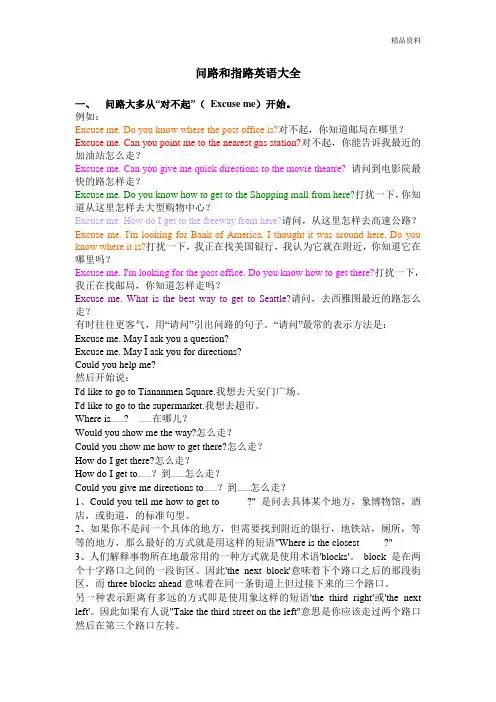
问路和指路英语大全一、问路大多从“对不起”(Excuse me)开始。
例如:Excuse me. Do you know where the post office is?对不起,你知道邮局在哪里?Excuse me. Can you point me to the nearest gas station?对不起,你能告诉我最近的加油站怎么走?Excuse me. Can you give me quick directions to the movie theatre?请问到电影院最快的路怎样走?Excuse me. Do you know how to get to the Shopping mall from here?打扰一下,你知道从这里怎样去大型购物中心?Excuse me. How do I get to the freeway from here?请问,从这里怎样去高速公路?Excuse me. I'm looking for Bank of America. I thought it was around here. Do you know where it is?打扰一下,我正在找美国银行,我认为它就在附近,你知道它在哪里吗?Excuse me. I'm looking for the post office. Do you know how to get there?打扰一下,我正在找邮局,你知道怎样走吗?Excuse me. What is the best way to get to Seattle?请问,去西雅图最近的路怎么走?有时往往更客气,用“请问”引出问路的句子。
“请问”最常的表示方法是:Excuse me. May I ask you a question?Excuse me. May I ask you for directions?Could you help me?然后开始说:I'd like to go to Tiananmen Square.我想去天安门广场。
人教新目标七年级英语下册课件Unit 8 英语学习问路指路

• It is on the right beside/ next to
• You can see it in front of you.
• go on till you reach the end.
Exercises for road signs(1)
She must look at thet_r_a_ff_i_c_l_ig_h_t_s_. when she is at the c_r_o_s_s_r_o_a_d_s_.
Read maps
Walk along this road.
Turn right when you come to the crossroads.
Where is the post office?
Post office
Bridge Street
on Bridge Street
Hotel Post office Bank between the hotel and the bank
Post office Bank
Park
Post office
The entrance is on your left.
Read maps
Turn left when you come to the corner of the road
Cross the road Walk along this road.
The entrance is in front of you.
行三分钟即到。
• Cross the street, walk on and take the second turning on the right, it’s three minutes’ walk.
Unit8 Is there a post office near here 问路和指路教案
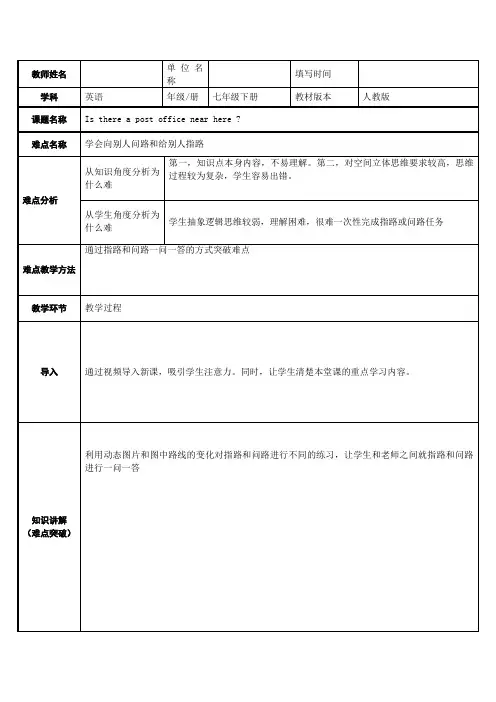
(难点巩固)
播放一段听力,让学生在听得同时再次感知本堂课的知识点,在熟练单词拼写的前提下,进行知识点的自我发现和剖析,对本课时难点进行梳理和巩固。
小结
罗列本节课指路和问路这个知识点会用到的基本句型,便于学生在实际生活中灵活运用。学科
英语
年级/册
七年级下册
教材版本
人教版
课题名称
Is there a post office near here ?
难点名称
学会向别人问路和给别人指路
难点分析
从知识角度分析为什么难
第一,知识点本身内容,不易理解。第二,对空间立体思维要求较高,思维过程较为复杂,学生容易出错。
从学生角度分析为什么难
学生抽象逻辑思维较弱,理解困难,很难一次性完成指路或问路任务
难点教学方法
通过指路和问路一问一答的方式突破难点
教学环节
教学过程
导入
通过视频导入新课,吸引学生注意力。同时,让学生清楚本堂课的重点学习内容。
知识讲解
(难点突破)
利用动态图片和图中路线的变化对指路和问路进行不同的练习,让学生和老师之间就指路和问路进行一问一答
人教版英语7年级下册 Unit 8 如何用英语问路指路
如何用英语问路指路1. 在向人问路之前,一般应先说句Excuse me,这样一方面可引起对方注意,另一方面又显得比较客气。
Excuse me,译成汉语不一定总是“对不起”,此时也可译为“劳驾”,“请问”等。
若对方讲的话你没听清,你可以说I beg your pardon?(用升调,意为:对不起,我没听清)或Would you please say it again?I‘m afraid I didn’t quite catch you.(请再说一遍好吗?我恐怕没有完全听清)。
问完路之后,应向指路人表示感谢。
2.“向左(右)拐”英语有两种常见的说法:turn left(right)或turn to the left (right)。
表示“在左(右)边”,英语用介词on 或at 均可。
如Turn left and walk on,and soon you‘ll see a tall building on [at] the left. (向左拐,然后继续走,不久你就会看到左边有一座高楼)。
另外,按照我国的交通规则是“行人靠右”,而在英国你会看到这样的交通标牌Keep to the left(靠左边走)。
3. 有时人们在给对方指路后,还往往加上一些句子,以表示他的引路信息介绍完毕。
如:You can‘t miss it (你不会找不到的),You are sure to get there(你一定会到达那儿的),You can’t go wrong (你不会走错的)。
一、如何用英语问路常用的问路句型1.Excuse me,can you tell me the way to……?2.Ex cuse me, would you like to tell me the way to……?3.Where is ……?4.How can I get to ……?5.Do you know the way to ……?6.I wonder where …… is.7.I wonder the way to…….二、问路程及交通方式的句型How far is the bus stop from here?汽车站离这儿有多远?How can I get there?我怎么去那里?Which bus shall I take?我应该坐哪一路车?三、指路常用的句型1.Take along with this street, and ……is on you left.2.Go down this way, and turn left at the firt crossing, and you 'll find ……is right there, on your left.3.……is behind(near, next to, on the left of)……4.You can just take NO.111 bus, and get off at the second station. And you 'll see it.5.Look! ……is in front of us far away, right there!四、感谢常用句型1.当别人为你指路时,你应该用Thank you very much./Thanks a lot. 等来表示感谢。
七年级下册八单元英语作文 问路
文章标题:A Journey of Inquiry: Navigating the Path of Asking for DirectionsIn the bustling cityscape, the sounds of life echo through the streets, a symphony of people, vehicles, and the constant flow of activity. Amongst this cacophony, a young explorer stands, perplexed and slightly nervous, facing a crossroads unknown. This is the story of Alice, a girl on a mission to find her way, armed only withcuriosity and the courage to ask for directions.Alice had ventured out on her own for the first time, excited about the adventure that awaited her. However, her excitement soon turned to confusion as she realized that she had lost her way. Standing at the intersection, she surveyed the surrounding landmarks, trying to recognize any familiar sights. But the towering buildings and the maze of streets seemed to mock her attempts, offering no clues to her destination.Determined not to let her misstep dampen her spirit, Alice decided to ask for help. She approached a passerby, a kindly-looking elderly woman, and summoned her courage."Excuse me, could you please tell me how to get to the City Park?" she asked, her voice slightly trembling.The woman smiled warmly and pointed in the direction of the park. "You can take the bus from the stop over there," she explained, gesturing to a nearby bus stop. "Just follow the signs and you'll be there in no time."Alice thanked the woman profusely and made her way to the bus stop. As she waited, she realized that asking for directions wasn't as daunting as she had imagined. In fact, it had been a pleasant experience, one that had left her feeling more confident and excited about her adventure.On the bus, Alice observed the cityscape through the window, noting the landmarks and streets that she had passed. She made a mental note of the route, committing it to memory for future reference.When she finally arrived at the City Park, Alice felt a sense of accomplishment wash over her. She had not only found her way, but she had also overcome her initial nervousness and learned a valuable lesson. She realizedthat asking for directions was not only necessary but also a valuable tool for navigation in the world.Reflecting on her journey, Alice understood that life was often like this: a series of crossroads and unknown paths that required courage and curiosity to navigate. She was grateful for the kindness of the woman who had helped her and resolved to pass on the same kindness to others in the future.As Alice walked through the park, her heart filled with joy and anticipation for the adventures that still awaited her. She knew that with every step she took, she was growing stronger and more resilient, ready to face the challenges that life might throw at her.And so, the story of Alice's journey continues, a tale of inquiry and discovery, where every asked direction leads to a new understanding of the world and herself.**问路之旅:探寻指路的道路**在喧嚣的城市景观中,生活的声音回荡在街头巷尾,构成了一幅由人、车辆和不断流动的活动组成的交响乐。
英语七下第8单元对话问路范文
英语七下第8单元对话问路范文In the bustling city, the sun was just beginning to set, casting long shadows on the streets. It was a typical day for the Smith family, who were visiting the city for the first time. They were standing in front of a large map, trying to figure out the best route to the famous museum they had heard so much about."Excuse me, could you please help us? We're trying tofind our way to the National History Museum," said Mr. Smith, approaching a friendly-looking local.The local, a young man with a warm smile, replied, "Of course! You're in luck, the museum is just a few blocks away. Just head straight down this street until you see the big fountain, then turn right. You'll pass a park on your left, and the museum will be on your right."Mrs. Smith, a bit overwhelmed by the city's hustle, asked, "Is there a shortcut we could take? We have a bit of a tight schedule."The young man thought for a moment and then said, "Well,if you don't mind a bit of a walk, you could take a small alleyway just behind you. It's a bit less crowded and willlead you to the same street with the fountain. From there,it's the same directions."Their daughter, curious and eager, chimed in, "What about public transportation? Is there a bus or subway we could take?"The local nodded, "Absolutely, you can take the number 12 bus right from the stop over there. It will drop you offright in front of the museum. Just make sure to check the bus schedule so you don't miss it."Mr. Smith thanked the local, "That's very helpful. We appreciate your assistance."The young man waved off the thanks, "No problem at all. Enjoy your visit to the museum!"With the directions in hand, the Smith family set off, feeling more confident about navigating the city. They knew that with a bit of help and a friendly local's advice, they could explore and enjoy all the city had to offer.。
七下英语第八单元指路的范文
七下英语第八单元指路的范文When someone asks you for directions, it's important tobe clear and specific to help them reach their destination easily. Here are some useful phrases and tips for giving directions in English:1. Start by using landmarks to help the person orient themselves. For example, you could say, "Go past the library and turn left at the post office."2. Use cardinal directions (north, south, east, west) to give a general sense of where things are located. For instance, "The café is to the east of the park."3. Give steps or turns in a logical order. Instead of saying, "Turn right, then left, then right again," try saying, "Go straight for two blocks, turn left at the intersection, and the store will be on your right."4. Use street names or numbers when necessary. For example, "Take Main Street until you reach Maple Avenue, then turn right."5. Be polite and patient when giving directions. If the person seems confused, offer to repeat the instructions or draw a simple map for them.Remember, giving clear and accurate directions can make a big difference for someone who is unfamiliar with the area. By following these tips, you can help others navigate their way with confidence.。
- 1、下载文档前请自行甄别文档内容的完整性,平台不提供额外的编辑、内容补充、找答案等附加服务。
- 2、"仅部分预览"的文档,不可在线预览部分如存在完整性等问题,可反馈申请退款(可完整预览的文档不适用该条件!)。
- 3、如文档侵犯您的权益,请联系客服反馈,我们会尽快为您处理(人工客服工作时间:9:00-18:30)。
如何用英语问路指路
一、在向人问路之前,一般应先说句Excuse me,这样一方面可引起对方注意,
另一方面又显得比较客气。
Excuse me,译成汉语不一定总是“对不起”,此时也可译为“劳驾”,“请问”
等。
若对方讲的话你没听清,你可以说I beg your pardon?(用升调,意为:对不起,我没听清)或Would you please say it again?I‘m afraid I didn’t quite catch you.(请再说一遍好吗?我恐怕没有完全听清)。
问完路之后,应向指路人表示感谢。
二、“向左(右)拐”英语有两种常见的说法:turn left(right)或turn to the left
(right)。
表示“在左(右)边”,英语用介词on 或at 均可。
如Turn left and walk on,and soon you‘ll see a tall building on [at] the left. (向左拐,然后继续走,不久你就会看到左边有一座高楼)。
另外,按照我国的交通规则是“行人靠右”,而在英国你会看到这样的交通标牌Keep to the left(靠左边走)。
三、有时人们在给对方指路后,还往往加上一些句子,以表示他的引路信息介
绍完毕。
如:
You can‘t miss it (你不会找不到的),
You are sure to get there(你一定会到达那儿的),
四、常用的问路句型
1. Excuse me, can you tell me the way to……?
2. Excuse me, would you like to tell me the way to……?
3. Where is ……?
4. How can I get to ……?
5. Do you know the way to ……?
6. I wonder where …… is.
7. I wonder the way to…….
五、问路程及交通方式的句型
How far is the bus stop from here?汽车站离这儿有多远?
How can I get there?我怎么去那里?
Which bus shall I take?我应该坐哪一路车?
六、指路常用的句型
1. Take along with this street, and ……is on you left.
2. Go down this way, and turn left at the firt crossing, and you 'll find ……is
right there, on your left.
3. … is behind (near, next to, on the left of)……
4. You can just take NO.111 bus, and get off at the second station. And you 'll see
it.
5. Look! ……is in front of us far away, right there!
七、感谢常用句型
1.当别人为你指路时,你应该用Thank you very much./Thanks a lot. 等来表
示感谢。
2.当你请求别人帮助,但对方由于某种原因无法帮助你而表示歉意时,你应
该礼貌地回一声:Thank you all the same.(仍然要谢谢你。
)。
